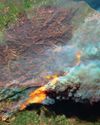Intentar ORO - Gratis
Laser Beams Discover a Lost World
Muse Science Magazine for Kids
|April 2022
A POWERFUL NEW ARCHAEOLOGY TOOL REVEALS COUNTLESS MAYA STRUCTURES.

On a summer day in 2017, a group of researchers board a small plane in northern Guatemala in Central America. It takes off from the runway and climbs high into the air. Lush green jungle stretches far into the horizon. Its dense canopy covers the uneven landscape, giving it the appearance of a rolling green sea. It's a beautiful sight. But the researchers inside the cockpit aren't here for the view. They have come to discover what lies beneath the thick, sprawling greenery.
Centuries ago, during about 1,800 BCE to 900 CE, the Maya civilization called this low-lying swampy area home. They were skilled farmers and brave warriors. They studied science, mathematics, and medicine. The Maya people honored their gods by offering sacrifices and building great cities filled with pyramids, palaces, and temples. But sometime around 900 CE, the Maya mysteriously abandoned their cities. Slowly, their monuments and temples began to crumble.
In 1839, American archaeologist John Lloyd Stephens and English artist Frederick Catherwood visited the deserted ruins of this forgotten civilization. By then, the jungle had reclaimed the land. The invading tangle of foliage swallowed up palaces I and monuments. Roads and temples turned into green swellings that blended in with the forest. Stephens described stone columns carved with images as “equal to the finest monuments of the Egyptians."
Following their expedition, other researchers continued the search throughout northern Guatemala, finding one individual Maya structure at a time. These disconnected discoveries made it difficult to put together the full story of how the Maya really lived-until now. Recent advancements in laser technology are revealing the lost world of the Maya and have scientists wondering if they understood this civilization as well as they had thought.
Esta historia es de la edición April 2022 de Muse Science Magazine for Kids.
Suscríbete a Magzter GOLD para acceder a miles de historias premium seleccionadas y a más de 9000 revistas y periódicos.
¿Ya eres suscriptor? Iniciar sesión
MÁS HISTORIAS DE Muse Science Magazine for Kids

Muse Science Magazine for Kids
ANIMAL FIREFIGHTER TO THE RESCUE
Can animals help manage the risks of deadly wildfires?
3 mins
Muse July 2025: The Story Behind Wildfires

Muse Science Magazine for Kids
FIRE DANGER
WHY THE RISK OF WILDFIRES KEEPS GROWING
4 mins
Muse July 2025: The Story Behind Wildfires

Muse Science Magazine for Kids
The Miller NEW Normal
WHAT TODAY’S WILDFIRES TELL US ABOUT OUR FUTURE
8 mins
Muse July 2025: The Story Behind Wildfires

Muse Science Magazine for Kids
WOMEN AND FIREFIGHTING: A GOOD FIT
Jessica Gardetto is a firefighter. Her father was, too. “I grew up with my dad coming home smelling like wildfire and covered in soot,” she says.
1 min
Muse July 2025: The Story Behind Wildfires

Muse Science Magazine for Kids
What is happening on your fingertips when they get all wrinkly in a hot tub?
—Felix G., age 10, Montana
1 mins
Muse July 2025: The Story Behind Wildfires

Muse Science Magazine for Kids
WHEN the SMOKE CLEARS
THE LINGERING EFFECTS OF THE RECENT PACIFIC PALISADES AND ALTADENA EATON FIRES
6 mins
Muse July 2025: The Story Behind Wildfires

Muse Science Magazine for Kids
PICKING TEAMS
Keep it fair with a strategy that relies on geometry.
2 mins
Muse July 2025: The Story Behind Wildfires

Muse Science Magazine for Kids
SHAN CAMMACK
WILDLIFE BIOLOGIST AND FIRE SAFETY OFFICER
3 mins
Muse July 2025: The Story Behind Wildfires

Muse Science Magazine for Kids
Scientists Create Mice With Woolly Mammoth-Like Fur
RESEARCHERS AT A COMPANY IN TEXAS ARE WORKING TO CREATE A LIVING ANIMAL THAT RESEMBLES THE EXTINCT WOOLLY MAMMOTH. Recently, they produced mice with traits of the large mammal. The mice all have coats with mammoth-like fur, and some of the small mammals also have genes that help them store fat. Both features would help the animals survive in the cold Arctic, where the woolly mammoth once lived.
1 min
Muse July 2025: The Story Behind Wildfires

Muse Science Magazine for Kids
Cool Sunshade Added to the Nancy Roman Space Telescope
THE NANCY ROMAN SPACE TELESCOPE IS A NEW TELESCOPE THAT NASA IS BUILDING AND WILL LAUNCH INTO SPACE, LIKELY IN EARLY 2027.
1 min
Muse July 2025: The Story Behind Wildfires
Translate
Change font size
